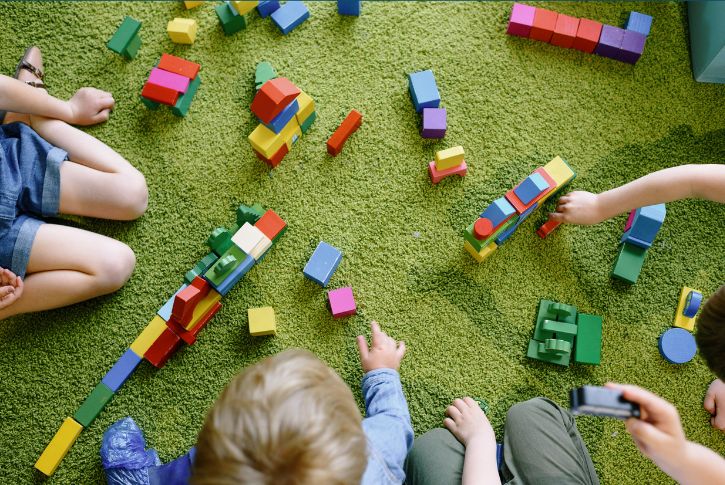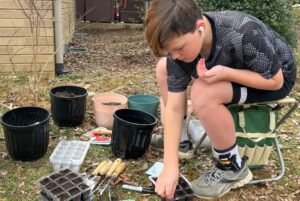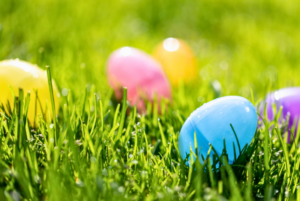Playing is crucial for early childhood development and learning – and it’s fun!
As a busy mom I know how tough it is to fit a toddler “lesson” into an already busy day. Working from home, house chores, siblings, pets, and running the mom taxi can really fill a schedule. As parents, we know that we need to make time for teaching our littlest learners, but where do we find that time? Let’s shake that mom guilt together, because studies show that our kiddos are learning through their play time. That’s right, we don’t need to fret if they aren’t spending every day seated, with a pencil in hand, because little learners learn through PLAY.
Aschildren grow and develop so do their abilities and interests. By choosing appropriate and fun ways to engage early learners at each age, we can help our kids reach and surpass the developmental milestones. Knowing what sort of play based learning activities are the right choice can certainly be challenging. We have done the research and compiled a list of play centered, smile engaging, FUN activities from experts in the Early Education field for you to try with your early learner!
Your Baby at 2 Months Old

For fun ways to introduce PLAY into your 2 month old’s day? Here are some great developmental activities recommended by Pathways that will help your little one grow and learn.
- “Hand Puppet Play: Place a puppet on your hand. Move puppet up and down, while saying baby’s name. See if they can follow the movement. Then move the puppet in a circle. As soon as they are able to follow the movement, try different movements. Helps baby develop vision skills.
- Gentle Dance: Turn on some of your favorite music. Hold baby close while you sway to the rhythm and sing along. Helps baby be calmly introduced to new sounds and words.
- Reach For It: Show baby a toy and move it towards their hand. Encourage baby to touch it. Be sure to switch sides so both hands get a chance to feel. You can even use common household items like measuring spoons. Helps baby learn to move their fists from closed to open.”
Hop over to the CDC’s Milestone Moments Checklist to check what milestones your child has reached.
Your Baby at 4 Months Old

For fun ways to introduce PLAY into your 4 month old’s day? Here are some great developmental activities recommended by Heidi Murkoff of What to Expect that will help your little one grow and learn.
- “Make Faces: At 4 months, your baby is emerging from the sleepier newborn phase and will begin to show more social skills — she’s probably beginning to master that sweet smile! And believe it or not, your little one may even be able to mimic simple facial expressions, particularly sticking her tongue out. Bring yourself to baby’s eye level, stick your tongue out and see if she’ll copy you. This simple game can help enhance her social and emotional, language and cognitive skills.
- Play with Textures: Grab a few objects with different textures — think a fuzzy blanket, a smooth fabric ball and a bumpy teething toy. Let your child touch the fabric (you may need to guide her hand). As she touches each one, use the identifying adjective to describe it: fuzzy, smooth, bumpy. Though your baby won’t yet understand the meaning of these words, she will begin to learn more about the world around her through her sense of touch — and it’s always good to encourage language development.
- Put on a Show: Now is your time to shine! Act out the sounds of barnyard animals, do the letter moves as you sing and dance along to the “Y.M.C.A.” song or come up with your own expressive performance to entertain your baby. The goal is to get your little one laughing at your over-the-top actions — an important social skill. Plus, as baby follows your movements, she’ll learn to focus her attention and improve tracking skills.
Hop over to the CDC’s Milestone Moments Checklist to check what milestones your child has reached.
Your Baby at 6 Months Old

For fun ways to introduce PLAY into your 6 month old’s day? Here are some great developmental activities recommended by Harvard that will help your little one grow and learn.
- “Sing Songs that Involve Movement: Try “Itsy Bitsy Spider” or “Trot, Trot to Boston” with words and motions.
- Play Peek-a-Boo: Try patty-cake too.
- Play Simple Games with Objects: Try putting toys into a bucket and taking them out then dropping them and saying boom!”
Hop over to the CDC’s Milestone Moments Checklist to check what milestones your child has reached.
Your Baby at 9 Months Old

For fun ways to introduce PLAY into your 9 month old’s day? Here are some great developmental activities recommended by Aliya Khan of FirstCry Parenting that will help your little one grow and learn.
- “Water Play: Bath time activity can be a great learning experience for the baby. When you talk to your baby, it helps in the little one’s language development. Your baby playing with the bubbles can help her develop hand-eye coordination. Your little one having fun while squeezing the water from a sponge or splashing water is a great way to develop her social-emotional skills etc. It is a time when, apart from touch, a baby’s other senses also get activated.
- Clapping and Singing: Babies start clapping by the time they are 9-months-old. Sing some nursery rhymes and clap along. Encourage her to clap to the rhythm. This helps toddlers develop control of their muscles and hand-eye coordination. It also helps them to learn about rhythms.
- Ball Rolling: Roll a medium sized blow-up ball towards your baby. See whether he stops it or not. Then encourage her to roll it back. Even if she does not, applaud her. You can ask your spouse to join in. This activity develops gross motor skills, teaches about taking turns and imitating.”
Hop over to the CDC’s Milestone Moments Checklist to check what milestones your child has reached.
Your Baby at 12 Months Old

For fun ways to introduce PLAY into your 12 month old’s day? Here are some great developmental activities recommended by Kimberly Knisley of Healthline that will help your little one grow and learn.
- “Create a Sensory Station: From the moment children are born, they use their five senses to learn about the world. Why? Our senses help us make sense of things in varying ways. Creating a sensory basket, or sensory station, will give your child the opportunity to explore new objects in a safe and creative way. You can fill a bin with rice, blocks, pasta, fabric, water, or dish soap bubbles and drop in toys or other items. Provide cups or scoops. Allow your little one to explore, digging through the materials and discovering items. An important note: Always supervise during these activities and don’t provide any items that could pose a choking hazard.
- Count on Fingers and Toes: Toddlers love to count things, so show your little one how to count by touching each of their fingers and toes as you recite the numbers.
- Sort Toys by Color: There are countless color-matching toys on the market — and for good reason. Color matching helps children develop their cognitive skills. Grab your favorite color-matching game or toy or make your own, using construction paper, paint, pom-poms, and/or popsicle sticks.”
Hop over to the CDC’s Milestone Moments Checklist to check what milestones your child has reached.
Your Baby at 15 Months Old

For fun ways to introduce PLAY into your 15 month old’s day? Here are some great developmental activities recommended by Jessica D’Argenio Waller, MS, CNS, LDN of Motherly that will help your little one grow and learn.
- Play Library: Set up a few stacks of kids’ books, make up a construction paper library card, and pretend to scan or “check out” library books at home with your kiddo. Now’s the time many toddlers start to get into pretend play, and setting up these imaginary scenarios can be so fun.
- Catch and Release: Encourage your child’s gross motor skills by rolling soft balls of different sizes. Show them how to roll the balls back and forth with you, or set up a mini bowling alley using empty plastic bottles or cardboard paper towel rolls as pins. You can also show them how to gently toss a ball into a laundry basket. Score!
- Shape Sorting: Introduce a shape sorting toy with large, colorful shapes. Guide your child in identifying and matching the shapes to their corresponding holes, helping them develop their cognitive skills and hand-eye coordination.”
Hop over to the CDC’s Milestone Moments Checklist to check what milestones your child has reached.
Your Baby at 18 Months Old

For fun ways to introduce PLAY into your 18 month old’s day? Here are some great developmental activities recommended by zerotothree that will help your little one grow and learn.
- Freeze Dance!: Play music and encourage the child to dance or move in whatever way he likes. Then instruct him to stop when the music ends. This kind of activity encourages listening skills and self-regulation as he practices stopping and starting. (This is a very useful skill for when he goes to school and has to follow a lot of directions!)
- Leaf Collector: Give the child a small basket and take her on a walk around your neighborhood or a local park or school. See if she wants to pick up leaves and other “treasures” and put them in her basket. You might be surprised by how long your toddler will be happy to walk, snapping up leaf after leaf for her collection. This activity builds gross motor (large muscle) and fine motor (small muscle) skills as children walk, squat, and pick up their discoveries.
- Squishy Sponges: Give the child some soaking wet sponges to play with outside. Let him wash his trike, the mailbox, or even stamp wet sponge-shapes onto the sidewalk. Show him how he can squeeze the sponge to make the water come out—this builds physical skills in his hands and fingers. Important jobs like washing a tricycle or baby doll help toddlers feel like confident and helpful members of the family. As with all water activities, it is critical to supervise children carefully as they play.”
Hop over to the CDC’s Milestone Moments Checklist to check what milestones your child has reached.
Your Baby at 2 Years Old

For fun ways to introduce PLAY into your 2 year old’s day? Here are some great developmental activities recommended by Caitlin van Wyk of Bright Sprouts that will help your little one grow and learn.
- “Animal Imitation: What toddler doesn’t love pretend play? You can use animal cards, toy animals, or even recorded animal sounds for this activity. Help your child think about how each animal moves and then watch as they try to imitate that movement. They can include the sound the animal makes to really get into character. Do this activity with your child. Yes, it may seem silly, but they will love it. Play is how our kids communicate with us, and something special happens when we join them in their world.
- Play Silks and Dancing: There is something magical about watching a child lost in their own world. Play silks are a great way to encourage imaginative movement in little kids. Put on some music and let your little one move to the rhythm. This unstructured activity allows them to use any movements they want. The play silks help them move their bodies, become aware of themselves within a space, and embody different characters. Try music that evokes different moods. Watch as your child adjusts their movements to the music.
- Mud Monster: Getting dirty is a great way to learn and a fun activity. Not only is mud a fantastic sensory experience, but it contains friendly bacteria that stimulate the release of serotonin. To create your mud monster, draw one on a wall with mud or build one around a hula hoop placed on the ground. Your toddler will then make mud balls and have to throw them into the mud monster’s mouth. Your 2-year-old is learning to throw overhand at this stage, and this is a fun activity to practice. Let your toddler help you make the mud. The process of mixing sand and water is a valuable learning opportunity.”
Hop over to the CDC’s Milestone Moments Checklist to check what milestones your child has reached.
Your Baby at 3 Years Old

For fun ways to introduce PLAY into your 3 year old’s day? Here are some great developmental activities recommended by Penn State Extension that will help your little one grow and learn.
- “Make Simple Instruments: Make simple instruments out of items such as an oatmeal box or coffee can for drums, dry beans in a box for shakers, etc.
- Draw and Scribble: Give children paint, crayons, chalk, and finger paints to draw and scribble. Remember, there is no right or wrong way to make art.
- Read Daily: Read books to your child every day.”
Hop over to the CDC’s Milestone Moments Checklist to check what milestones your child has reached.
Your Baby at 4 Years Old

For fun ways to introduce PLAY into your 4 year old’s day? Here are some great developmental activities recommended by PBS that will help your little one grow and learn.
- Shadow Puppets: When you and your child are outdoors relaxing on a sunny day, play with your shadows! Encourage your child to notice how your shadows look when you move around in different ways. How do our shadows look when we jump up and down, spin around or stand in front of/behind each other? Make shadow shapes together. Can we hold hands and make a circle/a square/a heart with our shadows? Can we make number and letter shapes? What other shapes can we make? Draw your shadows. How are your shadows similar to you? How are they different?
- Look for Colors in Nature: When you are out and about with your child, help him notice the variety of colors in nature. Draw his attention to the different shades of green in a single plant or leaf and the different shades of pink or purple in a flower. How do colors outdoors look on bright sunny days? How do they look on dark cloudy days? Invite your child to draw a sunny day or cloudy day picture. What colors will he use to show how colors look brighter or darker on different days? Continue to call out shapes, and he will continue to hop.
- Obstacle Course: Using chairs, tables, pillows and anything else you have, create an indoor obstacle course! Use spatial words such as “over,” “under,” “through” and “around” to explain the route. You will help your child learn how to navigate through space while increasing their spatial vocabulary.
Hop over to the CDC’s Milestone Moments Checklist to check what milestones your child has reached.
Your Baby at 5 Years Old

For fun ways to introduce PLAY into your 5 year old’s day? Here are some great developmental activities recommended by The Lego Foundation that will help your little one grow and learn.
- “Lego blocks: Legos are great toys for 5 year olds. Legos boost the learning and imaginative skills of your preschooler through building roleplay with princesses, sports, fantasy, dragons, dinosaurs and STEM learning.
- Make Paper Airplanes: Can you build a paper plane that flies? Try this fun paper plane game which helps you learn how to solve problems by testing ideas, practice concentrating and get better at handling frustrations. You can make the paper plane game even trickier by adding weights to your plane.
- Create Craft Pets: Toilet roll tubes. Wooden sticks. Pipe cleaners, sticky tape and crayons or other craft materials Why not make one, two or even more with this fun activity that will test out your creativity and boost hand and eye coordination. Make your own pet as wild and crazy as you like.”
Hop over to the CDC’s Milestone Moments Checklist to check what milestones your child has reached.
Playing Is Powerful!
The power of play in early education cannot be overstated. It’s a joyful, engaging, and effective way to support children’s development. By embracing play-based learning, we can help our youngest learners build the skills they need to thrive in school and beyond. So, let’s celebrate the power of play and continue to create enriching, playful experiences for our children.





